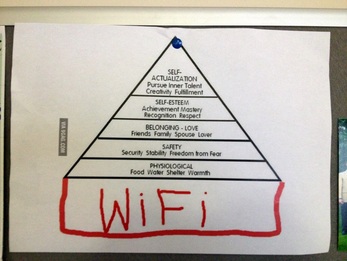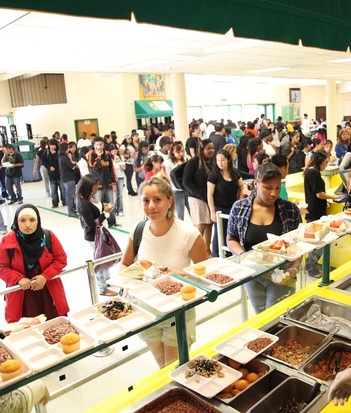
Oh boy, was I wrong.
I think the future of schools lies in this very pyramid (yes, including the "WiFi" addition to the bottom).
What Maslow says in a nutshell is that physiological, safety, "love and belonging" and self-esteem needs must be met before any substantive learning can take place. If one comes from the 10th richest county in the United States, chances are one probably will not be affected by the bottom blocks (food, water, shelter, safety, etc.), although one never knows...
Here's where schools need to step in! Children who are missing these basic necessities in their lives can be provided them at school. For example:
- A school breakfast program, coupled with a normal school lunch (and possibly even a late lunch after school) would fix a large portion of their food needs.
- Extra-curricular activities and sports are a must, especially as many parents work from 9am to 5pm (or later) and have difficulty finding and paying for someone to watch their children. Activities also keep kids out of trouble, allow students to explore topics that interest them, and create friendships so the more activities the better!
- A medical and dental service, and not necessarily only for its students! Some schools have a nurse full time and have a doctor come and do check-ups once or twice a week, for both students and families.
- Student Resource Officers are police officers from the community who either visit or work in schools during regular (and/or afterschool) hours. SROs are common in many schools and serve a crucial community-outreach role necessary for students to feel safe and have someone they can talk to specifically about safety issues.
| I try to be very conscious of economics and I realize that in this day and age all of these services can cost a great deal of money. That is where school districts come in handy. Many states define districts differently, like New Jersey and South Carolina for example: South Carolina has county-wide districts (ex. the Charleston County School District), while New Jersey has primarily municipal and some regional districts. Schools in districts can share services with one another, working together to provide the best services for their students. One doctor who rotates between schools, extra-curricular activities that alternate days, etc. Districts can also team up to provide services in tandem, again rotating resources and sharing the costs: a district with more pupils could have the doctor more than one without, or something like that. |



 RSS Feed
RSS Feed
